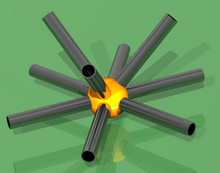Octa plate

The octa plate is a structural element in steel construction . It serves as a connecting element in a spatial framework . The component developed by Josef Fröhlich at Mannesmann in 1959 is a hollow sphere made of S355 steel to which eight pipes are welded, which usually lie in three planes, each at a 60 ° angle to one another. The connecting element is also used for visible supporting structures, such as in the Church of the Holy Cross in Düsseldorf-Rath .
One advantage of the octaplate was that pipes cut to length at right angles can be welded directly to the ball without any further preparatory manufacturing steps. Today, the amount of work required for the integral connection technology is a disadvantage. This prompted Mannesmann to develop a form-fitting variant, the Okta-S plate, with bolts as a connecting element.
The Mero company also developed the construction principle further. Today, a large number of very different prefabricated truss nodes are offered by various companies .
literature
- Josef Fröhlich: Octa plate in tube construction . In: Steel construction . tape 28 , no. 9 , 1959, pp. 255-256 .
- W. Lohse: Steel construction 2 . 20th edition. Teubner, 2005, ISBN 3-519-25255-4 .
- ZS Makowski: Development of Jointing Systems For Modular Prefabricated Steel Space Structures . In: Proceedings of the International Symposium “Lightweight Structures in Civil Engineering”, 24. – 28. June 2002 . Warsaw, S. 255–256 ( fema.pl [PDF; accessed on May 24, 2011]).
Web links
Individual evidence
- ↑ generativedesign.com (Retrieved May 24, 2011)


